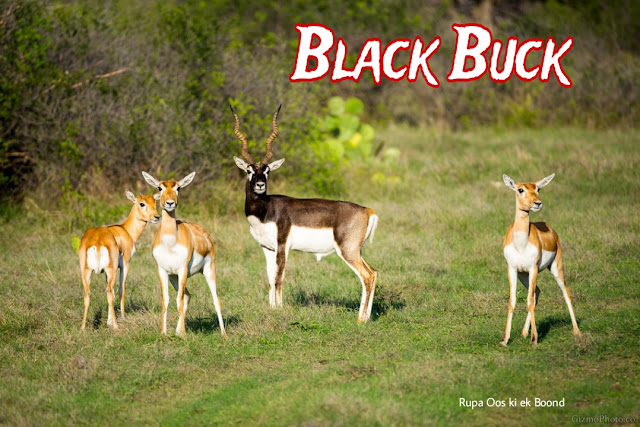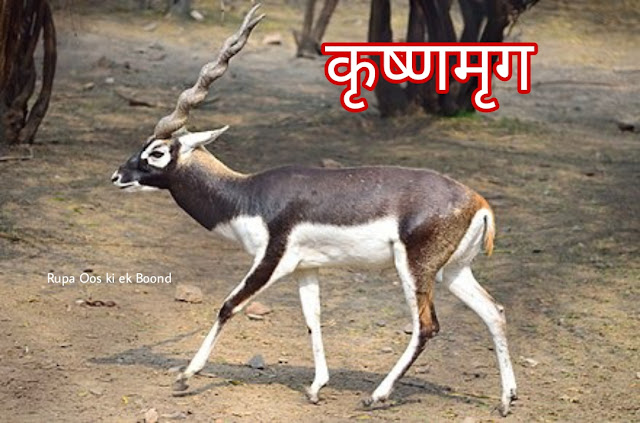काला हिरण (Black Buck/ब्लैक बक)
वर्ष 1985 में इंडियन बोर्ड फॉर वाइल्ड लाइफ ने भारत के सभी राज्यों और केंद्र शासित प्रदेशों से अपना राजकीय पक्षी, पशु, वृक्ष और पुष्प चिन्हित करते हुए उन्हें अधिघोषित करने के लिए कहा था। वर्ष 2014 में आंध्र प्रदेश को दो भागों (आंध्र प्रदेश और तेलंगाना) में बांटा गया था। विभाजन के उपरांत तेलंगाना में चले गये आंध्र प्रदेश के कुछ भाग से आंध्र प्रदेश की पारिस्थितिकी भी दो भागों में विभाजित हुई, जिसके चलते नये राजकीय चिन्ह जारी करना आवश्यक था। आंध्र प्रदेश के विभाजन के चार वर्ष बाद 30 मई 2018 को आंध्र प्रदेश के पर्यावरण, वन, विज्ञान एवं तकनीक विभाग द्वारा राज्य के नये राजकीय चिन्हों की घोषणा की गई। आंध्र प्रदेश का राजकीय पशु "काला हिरण ( Black Buck )" है। इसको अंग्रेजी में "ब्लैक बुक्क" कहा जाता है। यह आंध्र प्रदेश के अलावा हरियाणा और पंजाब का भी राज्य पशु है।
काले हिरन की प्रजातियों का वर्णन सबसे पहले 1758 में स्वीडिश जीव विज्ञानी कार्ल लिनिअस ने किया गया था।स्थानीय रूप से, आंध्र प्रदेश में, काले हिरण को "कृष्ण जिंका" कहा जाता है। इसके चेहरे पर काली धारियां होती हैं, जो ठुड्डी और आंखों के आसपास सफेद फर से बिल्कुल विपरीत होती हैं। नर अलग-अलग होते हैं, क्योंकि उनका रंग दो-रंग का होता है, जबकि मादाएं और युवा थोड़े गहरे भूरे रंग के होते हैं।
"काले हिरन (कृष्णमृग)" का वैज्ञानिक नाम ‘Antilope Cervicapra’ है, जिसे ‘भारतीय मृग’ (Indian Antelope) के नाम से भी जाना जाता है। यह भारत और नेपाल में मूल रूप से निवास करने वाली मृग की एक प्रजाति है।ये राजस्थान, गुजरात, मध्य प्रदेश, तमिलनाडु, ओडिशा और अन्य क्षेत्रों में (संपूर्ण प्रायद्वीपीय भारत में) व्यापक रूप से पाए जाते हैं। ये घास के मैदानों में सर्वाधिक पाए जाते हैं। इसे चीते के बाद दुनिया का दूसरा सबसे तेज़ दौड़ने वाला जानवर माना जाता है। कृष्णमृग एक दैनंदिनी मृग (Diurnal Antelope) है अर्थात् यह मुख्य रूप से दिन के समय ज़्यादातर सक्रिय रहता है। जल, कृष्णमृग की दैनिक आवश्यकता है इसलिए वे पानी के पास रहना पसंद करते हैं।
काले हिरन (एंटीलोप सेरवीकप्रा) को भारतीय मृग अथवा हिरन के रूप में भी जाना जाता है। इसकी ऊंचाई 74 से 84 सेमी. तक होती है। नर हिरन का वजन 20-57 किलोग्राम होता है, जबकि मादा हिरन का वजन औसतन 20-33 किलोग्राम होता है। यह 50 किलोमीटर प्रति घंटे की गति से भाग सकता है। नर कृष्णमृग के सींग चक्राकार होते हैं जो 35-75 सेमी लंबे होते हैं। मादा कृष्णमृग के भी सींग हो सकते हैं। कृष्णमृग शाकाहारी होता है। घास का भक्षण करता है। काले हिरन में गर्भकाल का समय आम तौर पर छह महीने का होता है, जिसके बाद एक शावक का जन्म होता है। इसका जीवन काल 10 से 15 वर्ष तक होता है।
1972 के वन्य जीव संरक्षण अधिनियम की पहली अनुसूची के तहत भारत में कृष्णमृग (काले हिरन) का शिकार करना प्रतिबंधित है। कृष्णमृग 30 नर गुणसूत्र होते हैं जबकि मादा कृष्णमृग में 31 गुणसूत्र होते हैं। कृष्णमृग के प्रमुख शिकारियों में भेड़िये, चीते और जंगली कुत्ते शामिल हैं। (साल 1998 के सितंबर-अक्टूबर के महीने में जोधपुर में फिल्म 'हम साथ साथ हैं' की शूटिंग के दौरान सलमान खान अपने साथी कलाकारों के साथ भवाद गांव की तरफ शिकार करने के लिए गए थे. जहां 27-28 सितंबर 1998 की रात घोड़ा फार्म हाउस में काले हिरण का शिकार किया गया था, जिसका इल्जाम सलमान खान पर था।)
भारतीय उपमहाद्वीप में कृष्णमृग रेगिस्तान (उत्तर-पश्चिमी क्षेत्र में), तटीय क्षेत्रों और पहाड़ों (उत्तरी-पूर्वोत्तर क्षेत्र में) में भी देखे जा सकते हैं। कृष्णमृग को गर्म जलवायु पसंद है। आईयूसीएन (अंतर्राष्ट्रीय प्रकृति संरक्षण संघ /IUCN) ने काले हिरन को लगभग विलुप्त प्राय जानवरों की श्रेणी में शामिल किया है।
English Translate
Black Buck
In the year 1985, the Indian Board for Wildlife had asked all the states and union territories of India to identify and declare their state birds, animals, trees and flowers. In the year 2014, Andhra Pradesh was divided into two parts (Andhra Pradesh and Telangana). After the partition, some parts of Andhra Pradesh went to Telangana and the ecology of Andhra Pradesh was also divided into two parts, due to which it was necessary to issue new state symbols. On 30 May 2018, four years after the bifurcation of Andhra Pradesh, the new state symbols of Andhra Pradesh were announced by the Department of Environment, Forest, Science and Technology of Andhra Pradesh. The state animal of Andhra Pradesh is "Black Buck". It is called "Black Book" in English. Apart from Andhra Pradesh, it is also the state animal of Haryana and Punjab.
The black buck species was first described by the Swedish zoologist Carl Linnaeus in 1758. Locally, in Andhra Pradesh, the black buck is called "Krishna Jinka". It has black stripes on its face, which contrast with the white fur on the chin and around the eyes. Males are distinguishable as they have a two-tone coloration, while females and young are slightly darker brown.
The scientific name of "Black Deer" is 'Antilope Cervicapra', which is also known as 'Indian Antelope'. It is a species of antelope native to India and Nepal. They are found widely in Rajasthan, Gujarat, Madhya Pradesh, Tamil Nadu, Odisha and other regions (all over peninsular India). These are found most in grasslands. It is considered to be the second fastest running animal in the world after the leopard. Blackbuck is a diurnal antelope, that is, it is active mainly during the day. Water is the daily requirement of blackbuck, so they like to live near water.
The blackbuck (Antilope cervicapra) is also known as the Indian antelope or deer. Its height is 74 to 84 cm. Happens till then. The weight of a male deer is 20-57 kg, while the weight of a female deer is on average 20-33 kg. It can run at a speed of 50 kilometers per hour. The male blackbuck has circular horns which are 35-75 cm long. Female blackbuck may also have horns. Blackbuck is a vegetarian. Eats grass. The gestation period in blackbuck is typically six months, after which one fawn is born. Its life span is from 10 to 15 years.
Hunting of blackbuck is prohibited in India under the First Schedule of the Wildlife Protection Act of 1972. Male blackbuck have 30 chromosomes while female blackbuck have 31 chromosomes. Major predators of blackbuck include wolves, leopards and wild dogs. (During the shooting of the film 'Hum Saath Saath Hain' in Jodhpur in the month of September-October 1998, Salman Khan along with his co-actors had gone to Bhavad village for hunting. Where on the night of 27-28 September 1998, the horse Black buck was hunted in the farm house, the blame for which was on Salman Khan.)
In the Indian subcontinent, blackbucks can also be seen in deserts (in the north-western region), coastal areas and mountains (in the north-eastern region). Blackbuck likes hot climate. The IUCN (International Union for Conservation of Nature) has included the black buck in the category of almost extinct animals.
भारतीय राज्य के राजकीय पशुओं की सूची || List of State Animals of India ||










V nice information 👍🏻
ReplyDeleteNice
ReplyDeleteVery nice
ReplyDeleteNice
ReplyDeleteबहुत बढ़िया जानकारी
ReplyDelete🙏🙏💐💐शुभरात्रि 🕉️
ReplyDelete🙏जय जय श्री राम 🚩🚩🚩
👌👌बहुत अच्छी जानकारी 🙏
🙏आप का बहुत बहुत धन्यवाद
💐💐
Good information 👍
ReplyDeleteGood
ReplyDeleteVery beautiful animals, very interesting information.
ReplyDeleteNice Information 👌🏻🙏🏻
ReplyDelete